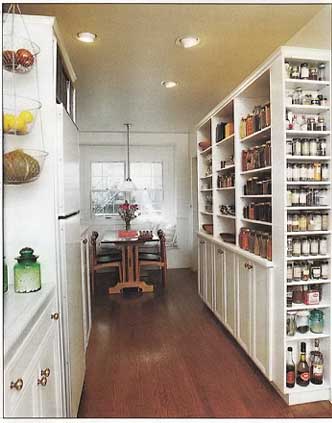Featured Articles:

As shown in image above, the need for plentiful storage led to a handsome
addition to this galley kitchen, with an inviting window seat in the eating
area. (read more...)
How-To's and DIY Guides / Tips:
Quick, Cost-Effective Home Upgrades:
- Planning Home Improvements
- The Exterior
- The Kitchen
- The Bathroom
- Living Areas
- Bedrooms and Hallways
- Utility Areas and General Upgrades
Thermostats
How Thermostats Work
Thermostats are switches that are turned on by a temperature-sensitive device
that, in turn, activates the switch controlling the operation of a boiler,
furnace, electric heater, air conditioner, or other heating or cooling device.
Low-voltage and milivolt thermostats are the most common types. The three
principal parts of a thermostat are:
- Heat Sensor Usually bi-metal coil, the heat sensor contracts as it
cools, tripping the switch to "on" and expands as it warms, tripping
the switch to "off".
- Switch The switch may have open contacts (in older models) or a mercury-type
contact enclosed in an airtight glass tube.
- Heat anticipator (found in low-voltage types only) The anticipator
prevents the living area from overheating by shutting off the boiler
or furnace just before the desired temperature is reached.
Top of Page
Installing a Thermostat
- After removing the old thermostat, feed the wires through the hole
in the new base plate and insert the screws.
- Level the plate, then tighten the screws.
- Strip the ends of the wires if needed, or scrape them clean.
- Wrap the ends clockwise around the terminal screws and tighten the
screws.
- Mount the thermostat on the base plate.
- Using a pencil, set the anticipator pointer to match the current
value marked on the gas valve.
Top of Page
Troubleshooting Garbage Disposals
The two types of garbage Disposals are:
- Batch Feed - Activated by turning a stopper
- Continuous Feed - Activated by a wall switch
Problems usually involve jams or clogs, or occasionally leaks.
Safety Tip
If dismantling the Disposal or working on electrical connections, shut
off power at the main disconnect. Never put your hand in the Disposal.
Use pliers or tongs to remove an object. Never pour a chemical drain
cleaner into a Disposal.
Top of Page
Troubleshooting a
Garbage Disposal
- If your Disposal makes a loud whirring noise or stops, it has jammed.
Turn it off and wait 5 minutes, then firmly press the reset button
on the bottom of the motor housing. (Machines without buttons reset
automatically).
- If the Disposal still doesn't work, see if it's designed to be unjammed
from below. It may have a small crank or a socket for an Allen wrench
to turn the flywheel. Or it may have a reversing switch.
- Lacking these, angle a broom handle against an impeller blade and
work the blade back and forth until the jam dislodges. Then press the
reset button.
- To cure a clog, disassemble the trap and use a snake.
- Water dripping from the Disposal usually indicates one or more seals
are worn and need to be replaced.
- Helpful Hint When professional help is required, take the Disposal
to the repair service to avoid paying for a service call. To remove
it, separate it from the drain elbow and loosen the mounting screws
to release it from the support flange.
- For best service from your Disposal, run cold water during disposal
and for a minute after.
- Never put glass, metal or rubber in the Disposal.
- Disposals vary, so consult your owner's manual.
Top of Page
You can't turn on the motor
Check for:
- No power.
- Defective on/off switch.
- Tripped overload protector switch.
- Defective motor.
Remedies:
- Check the fuse box/circuit breaker, and if the disposal is plugged
into a wall outlet, check the outlet.
- On continuous feed models, check the wall switch.
- On batch-feed models, check he stopper switch.
- If the flywheel is jammed, free it. Then, push the reset button.
- Call a qualified contractor.
Top of Page
Motor hums, but unit doesn't
grind
Check for:
- Jammed flywheel.
- Frozen motor bearings.
Remedies:
- Free the flywheel.
- Call a qualified contractor. You'll probably have to buy a new unit.
Top of Page
The disposal continuously blows
fuses
Check for:
- Too many appliances plugged into the circuit.
Remedies:
- Install a 15-amp circuit just for the disposal.
Top of Page
You can't stop the disposal
Check for:
Remedies:
- Call a qualified contractor.
Top of Page
The disposal drains slowly
Check for:
- Not enough water.
- Clogged drain line.
- Disposal isn't grinding finely enough.
Remedies:
- Run more cold water when using the disposal.
- Don't use harsh chemical agents.
- Flush with hot water to remove a grease clog, then remove the drainpipe
and clear it.
- Replace a dull shredder ring or any broken flyweights.
Top of Page
The disposal is making an unusual
amount of noise
Check for:
- Metallic object in the unit.
- Loose mounting screws are loose.
- Broken flyweight.
- The motor is defective.
Remedies:
- Inspect the unit and fish out the object with thongs or forceps.
- Tighten the mounting screws.
- Replace the broken flywheel.
- Call a qualified contractor.
Top of Page
There is a leak in the disposal
Check for:
- Loose sink connection.
- Loose drain connection.
- Damaged housing gasket.
Remedies:
- Tighten the flanges holding the gaskets or replace the gaskets.
- Tighten the drain flanges or replace the drain gasket.
- Replace the gasket.
Top of Page
Source: our affiliate partner: Acme Hardware
Top of Page
|

